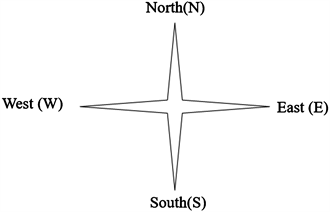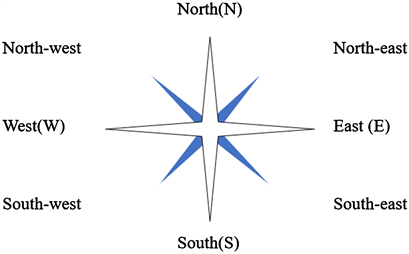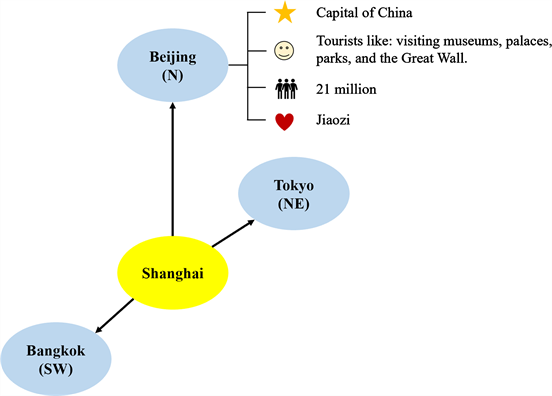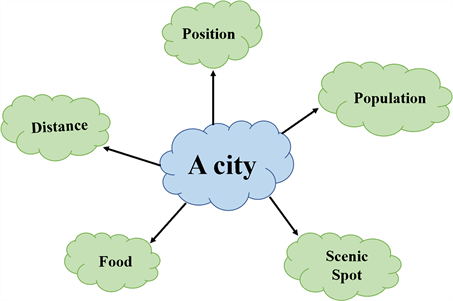The Application of Mind Mapping in English Foreign Language Teaching: A Case Study of Unit 1 Great Cities in Asia of the English Textbook for Grade Six (Oxford Shanghai Edition) ()

1. Introduction
The cognitive theory regards the learner as the controller of information processing, the information processor that uses various strategies to store and extract knowledge. Ausubel (1968) [1] mentioned that on the basis of the existing cognitive structure (cognitive schema), learners actively construct the structure of knowledge under the interaction with the external environment. The teaching theories of constructivism emphasize that the teacher is the organizer, the director, helper and promoter in the teaching process. In the process of designing teaching activities, students should be regarded as center of the lesson, not the teacher. The quality of teaching is measured by the improvement of learners’ ability to construct their own language knowledge system and language abilities rather than the ability to reproduce the teacher’s thought process. To reach this goal, the author tried to apply mind mapping to English teaching as English as a foreign language and designed a lesson plan of Unit 1 Great cities in Asia of the English Textbook for Grade Six (Oxford Shanghai Edition) to explain the application. Teaching methods such as the silent way, communicative language teaching and task-based language teaching are employed in this lesson plan.
2. Mind Mapping
Mind mapping is a tool to organize and express knowledge with diagrams, and it is a graphical representation of knowledge and thinking process. It usually places the related concepts of a topic in a circle or a square and other symbol, and then links the related concepts with a line to indicate the meaning relationship between the two concepts (Novak, 2001) [2] . Mind mapping is a cognitive tool and thinking technology. Divergent thinking mode is used to guide the thinking process, expand the thinking content, and visualize the thinking process (van der Wilt, etc., 2018) [3] . Mind mapping helps a lot in language teaching and learning.
2.1. Mind Mapping Facilitates Meaningful Learning
Meaningful learning occurs when new knowledge represented by symbols is associated with the existing concepts in learners' cognitive structures. Teaching is to help learn to incorporate new concepts into existing cognitive structures. An effective strategy for teachers to promote learning is to use relevant guiding materials to trigger learners to connect the new knowledge with the existing knowledge in the cognitive structure actively before presenting the new teaching content, so as to pave the way for meaningful learning in the end.
Teachers use mind mapping to stimulate the original ideas in the cognitive structure of learners, which provides a framework for learning new knowledge, and effectively promotes meaningful learning and the maintenance of acquired meaning.
2.2. Mind Maps as Effective Memory Aid
In the palace method, memory elements are fixed to a particular route or position, and association and imagination are the key to triggering memories. Branches in a mind map are specific routes and locations. During the creation and completion of a mind map, the brain is in a relaxed state, which can effectively improve thinking and memory. During the mapping process, the processed data is kept in the field of view. The classification keywords are very clear. Even if there is information missing in a certain link, the probability of recall can be improved by surrounding information prompts when people try to recall a certain keyword (Jiang Ning, 2018) [4] .
2.3. Mind Mapping Helps Foster Creative Thinking
Mind mapping emphasizes that learners think in a three-dimensional way. It establishes relationships between nodes in the diagram and combines concepts to form a divergent structure. Mind mapping can be a very important link and support for brainstorming. In the process of integrating existing information, learners can constantly derive new ideas on the old fulcrum and form a richer cognitive system through mutual connection. In the process of constructing mind map, learners' behaviors of adding nodes and modifying structure are the process of actively constructing personalized cognitive schema, which can effectively promote students' independent learning and innovative thinking.
3. The Application of Mind Mapping in EFL
The application of mind mapping method in college English vocabulary teaching can improve students’ learning interest, enhance their English proficiency, exercise their thinking and improve their comprehensible abilities (Gehong Liu, 2016) [5] . With the development and deepening of cognitive psychology and pedagogy and the practice of foreign language teaching, the cultivation of language ability, thinking ability and autonomous learning ability has become a new requirement of modern English teaching. The exam-oriented grammar translation method based on inculcating language forms has been difficult to meet this requirement. The use of mind mapping in teaching can guide learners to construct their own meaning in meaningful learning, so as to achieve a new and higher level of development from the current level of language cognition.
3.1. On Vocabulary Teaching
1) Use mind mapping to help learn new words
In English learning, students will remember one meaning of a word. But when the same word appears in another context, it is possible that it is a new word for them because this word has multiple meanings. Teachers can teach students to draw a clear mind map to distinguish the parts of speech, different meanings of words and common use so that they can remember polysemy more effectively.
2) Use mind mapping to expand vocabulary
English is an agglutinative language in which words are made up of morphemes. The most productive method of word formation is derivation, which refers to the relationship between root and affix. Mind mapping is helpful for students to analyze the morpheme composition of words, so that students can expand vocabulary from one morpheme to other words, so as to deepen their understanding of the meaning of words and expand their vocabulary efficiently.
For example, the new word “exhibition” in the lesson plan can be taught like this way (Figure 1).
3) Using mind map to build semantic field
Linguists have found that the vocabulary of English language is not a series of independent individuals, but all of them have their own domain or scope, and they are formed into a semantic field because they share some common features. “……the sense of a word may be seen as the network of its sense relations with others. In other words, sense may be defined as the semantic relations between one word and another, or more generally between one linguistic unit and another. It is concerned with the intralinguistic relations (Hu Zhuanglin, 1988) [6] . According to the relationship between semantics, the relationship between words can be divided into synonyms, antonyms and hyponyms. The hyponymy of words refers to the relationship between general words and concrete words. Concrete words tend to exist within general words. General words are also called supersemantic words and specific words are also called subsemantic words.
Figure 2 is an instance of the relationship of hyponymy. “Living” is the super- semantic word of “plant” and “animal”; “tiger” “sheep” “wolf” are sub-semantic words of “animal”. The relationship between them is a hyponymy.
The teaching of new words in the attached lesson plan also employed a mind map, which is constructed according to the logical relations between the words.
![]()
Figure 1. The mind map of the word “exhibition”1.
![]()
Figure 2. An example of words showing semantic relationship2.
In this way, students can get better understanding of the meaning of the words and the relations between the words (Figure 3).
3.2. On Reading Teaching
It has been proved that the effect of the mind map approach would be greater than the effect of reading approaches of traditional interactive reading and interactive reading with focused attention (van der Wilt and etc., 2019) [3] . Passages are rich in content, extensive in coverage, and numerous and diverse in knowledge. But the content of the article is a whole concentrated on one topic. The context is related to each other. Mind mapping is helpful for students to sort out the details of the article and to understand the structure of it. In this process, students not only master the information of the article better, but also develop their logical thinking ability, which is of great benefit to their reading and writing. In the lesson plan of unit 1, the construction of the mind map is divided into four steps (Figure 4).
Step 1: to find the topic of the passage―cities.
Step 2: to find out which cities the passage talks about―Beijing, Tokyo, and Bangkok. And there is another city: Shanghai, which functions as the reference point of the positions.
Step 3: to find more detailed information about the cities. Since students are in grade 6, teachers may give some hints by leading students to finish the “Beijing” part so that they will know how to draw this mind map about the other two cities.
From this example, it is clear that mind mapping helps teachers organize curriculum content into a more effective and integrated framework. When it serves
![]()
Figure 3. The mind map of the new words.
![]()
Figure 4. Part of the mind map of the passage.
as the presentation of language knowledge information in teaching, it will help learners organize, store and extract knowledge. In the process of making their own mind map, students gradually acquire the ability to use language and improve the ability of independent learning in the process of independent thinking.
3.3. On Spoken Language Teaching
Group discussion is a common form of classroom organization in oral English teaching, and cooperative learning is indispensable. Positive interdependence, individual responsibility, social support and cooperative strategy are the four important factors for students to learn actively and effectively (Liu Jinghua) [8] . Positive Interdependence means that all the members of the group share the same goal of learning. They should contribute to the group actively and share resources and responsibilities. The team members draw the mind map together, and the divergent association is not restricted to the form. The interest and autonomy of the group members closely combine them together, and they are interdependent, thus promoting the cooperation and communication among them.
Collaborative mind mapping provides a positive and relaxed collaborative environment for learners with each group member contributing to the branching of the map according to their own ideas. Group activity is no longer a simple combination of formal language communication. This method can not only make students get more innovative works, but also helps to improve their interest of learning and to enhance learners’ confidence and learning motivation. For example, in the task of designing a poster to introduce a city in the lesson plan, students are led to have a brainstorm with the help of mind maps so that they can come up with more creative ideas to get a good poster.
![]()
Figure 5. Part of the mind map of the talking topic.
4. Conclusion
In a word, the scaffolding teaching mode of mind mapping can be applied in the whole teaching process of foreign language listening, speaking, reading and writing. It helps to strengthen the connection between semantic knowledge and image knowledge, and stimulate the cognitive structure of learners and make them active. Mind mapping enables teachers to use old knowledge to promote new knowledge and teaching methods to promote learning, so as to help learners to achieve constructive learning, cumulative learning, cooperative learning and reflective learning, and finally to achieve real and meaningful language learning. This paper analyzes the application of mind mapping in English vocabulary, reading and oral English teaching. But there are more than these contents in EFL. The wider application of mind mapping remains to be explored.
Appendix
Lesson plan
Learning Unit Title
Unit 1 Great cities in Asia
Background/Summary
The topic of unit 1 is great cities.
1. There are introduction of some countries and cities and some expressions about travel.
2. There are many wh-questions used to ask for information. Students will learn:
・ “Which” questions to ask for relevant information, e.g. Which…is…?
・ “How” questions to find out means/ the length of a period of time/ distance
e.g. How can we travel to…?
How long does it take to…?
How far is it from…to…?
・ “Where” questions to ask for position, e.g. Where…?
How to ask questions and how to answer them should be taught.
Using prepositional phrases to indicate means to get somewhere: by plane/ship/train
Using nouns to indicate distance/ time: It’s about …kilometers. /It takes about…hours.
It takes about (number) and a half hours/ day.
3. Learn to express preferences: like/love/enjoy doing
4. Learn about adverbs to show position. Teachers may employ a compass to illustrate the eight positions. Introduce north-east, south-east, south-west, north-west on the base of the learned position north, south, east and west.
Grade Level
Sixth-grade primary
Timeframe
Four 45-minute lessons, 180 minutes in total.
Materials
Some pictures that can stand for the cities and countries in the unit.
A compass or a picture of it.
Enough A4-sized paper.
Some cards to make training aid.
Objectives
1. Cultivate students’ ability to obtain information.
2. Develop students’ ability of logical thinking so that they can get information integrated and connected.
3. Students can use their language knowledge learned in this unit to communicate with others.
Procedure Lesson One
1. Lead-in
Since this lesson is the first period of the new semester, the teacher can start with the topic of “vacation travel”. Form: teacher shares his (her) own travel experiences with students and then invite several students to share their trips with all class.
2. Words and Sentences
(1) Show some pictures of famous scenic spots, let them guess the cities.
(2) Introduce the exhibition of “Listen and say” on page 2 to teach new words and the question “Which city is the capital of ……?”
Part I: Asia, Japan, Tokyo, Thailand, Bangkok, capital
Use the map on page 2 and introduce these countries and cities in Asia. Use a hierarchical mind map to illustrate their relationships and the concept of “capital”.
The teacher can take Beijing and Shanghai as examples to explain the relationship between country and capital. The teacher can invite students to brainstorm about other countries they know in Asia.
T: look at the map. There are two great cities in China, Beijing and Shanghai. Which one is the capital of China? Which city is the capital of Japan? ……
T: Can you think of other countries in Asia?
Part II: north-east, south-east, south-west, north-west
Review the four directions of east, west, south, north with a picture of cross first.

T: Do you remember these directions? Tell me together (Point and wait for students’ answer).
Then add the new directions on to this cross (or use the compass on the text book).

*Inform students of the difference expression of direction between Chinese (东北) and English(North-east).
(3) Practice 1: use a picture of compass without words. Point to one direction and let students say it out quickly (it can be a competition between groups) to get students familiar with the new learned directions.
(4) Practice 2: Q-A practice
Take the conversation on page 2 as demonstration, give students a conversation task to talk about the cities according to an Asian map in pairs.
3. Listen and talk
(1) Listen to the conversation on page 3 and learn the language pattern:
How far is it from…… to……?
It’s about ……
How can we travel to ……?
We can travel by……
How long does it take to……?
It takes …… hours/minutes.
(2) Students listen to the tape and fill the blanks on page 3.
(3) Students can have a conversation practice following the language pattern according to the table they filled.
*Remind students of the difference between “How far” and “How long”.
Remind students how to read numbers.
4. Homework
Practice book P4 look.
Procedure Lesson Two
1. Lead-in: warm-up the words and sentences learned in the last lesson. Show pictures of cities and the compass to help students review.
2. Reading
(1) Introduce new words first.
(2) Let students read the passage by themselves to find some information.
T: Miss Guo and her students are reading some information about the great cities. You can also read it by yourself. Then, please tell me where are these cities.
(3) Ask questions about the details in the passage and help students to finish the mind map.
Where is Beijing/Tokyo/Bangkok?
How many people are there?
What do tourists like doing in Beijing/Tokyo/Bangkok?
What food do people in these cities like?
The teacher leads students to find the answer about Beijing in the first paragraph and teaches them how to draw mind map. Then the other two cities are left to finish by themselves. After finishing the mind map, the teacher asks these questions to check and correct.

3. Pair work: conversation practice
What food you like?
What do you enjoy doing at school?
*Plan B: If students can’t think of any activities they like, prepare some cards written with activities for them to pick and make sentences.
4. Homework
Find information about a city you want to travel to.
Practice book P3 look.
Procedure Lesson Three
1. Warm-up: prepare quiz card according to page 4 for students to pick. The student who answers a question will have the chance to pick a card and ask the question on it to another classmate.
2. Task: make a poster to introduce a city
Now that students have known some information about great cities. The teacher will give students a task of making a poster to introduce a city to attract tourists.
・ The poster may include pictures and text description. Students can write the text introduction by imitating the passage on the textbook.
・ Students should work in group (groups of four or five).
・ The teacher can help with the tools that students may need, such as scissors, glues, crayons, etc.
・ Students have 15 minutes to make their posters.
Before the discussion starts, the teacher leads the students to brainstorm what they want to present on the poster.

3. Paste the students’ works on the blackboard and introduce each of them.
4. Situational dialogue
Set a situation: we are making a travelling plan. Students can choose a city they are attracted to by the posters and talk about their travelling plan with classmates.
The travelling plan may include the following information:
Which city do you want to go?
Where is the city?
How can people get there and how long does it take?
What can tourist do in that city?
What do you like about the city?
The teacher will have this dialogue with one student as a demonstration. Then students work in pairs.
Procedure Lesson Four to Completion
Review lesson
1. The teacher leads students to review the words and sentences learned in this unit with pictures and mind map.
2. Finish the practices on the practice book and the teacher should check the answer and explain. Students may be invited to explain the answer.
Assessment
Teacher can make assessment of students’ acquisition of language knowledge according to their behaviors in lesson 3 and lesson 4.
Students’ ability of speaking English and logical thinking can be assessed by the teaching activities of drawing mind map of the passage and designing of posters.
If a student can draw the mind map without help, he/she has good ability to obtain and organize information logically.
NOTES
1Figure 1 is designed by the author, so are Figures 3-5 below.
2Figure 2 is an example from Mao Haiyan and Shan Xionglei, The Application of Mind Mapping in Vocabulary Teaching (2008) [7] .